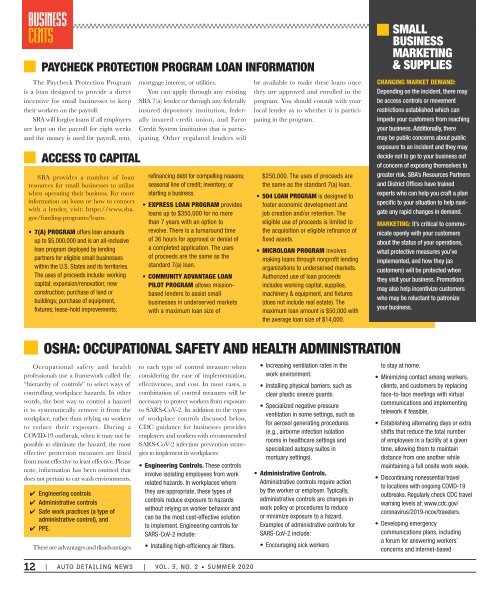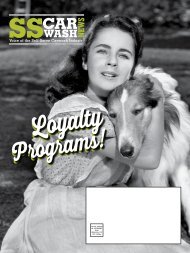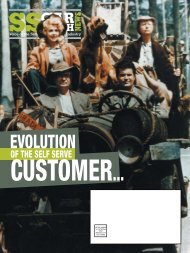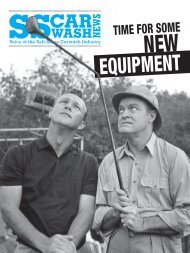You also want an ePaper? Increase the reach of your titles
YUMPU automatically turns print PDFs into web optimized ePapers that Google loves.
BUSINESS<br />
CENTS<br />
PAYCHECK PROTECTION PROGRAM LOAN INFORMATION<br />
The Paycheck Protection Program<br />
is a loan designed to provide a direct<br />
incentive for small businesses to keep<br />
their workers on the payroll.<br />
SBA will forgive loans if all employees<br />
are kept on the payroll for eight weeks<br />
and the money is used for payroll, rent,<br />
ACCESS TO CAPITAL<br />
SBA provides a number of loan<br />
resources for small businesses to utilize<br />
when operating their business. For more<br />
information on loans or how to connect<br />
with a lender, visit: https://www.sba.<br />
gov/funding-programs/loans.<br />
• 7(A) PROGRAM offers loan amounts<br />
up to $5,000,000 and is an all-inclusive<br />
loan program deployed by lending<br />
partners for eligible small businesses<br />
within the U.S. States and its territories.<br />
The uses of proceeds include: working<br />
capital; expansion/renovation; new<br />
construction; purchase of land or<br />
buildings; purchase of equipment,<br />
fixtures; lease-hold improvements;<br />
mortgage interest, or utilities.<br />
You can apply through any existing<br />
SBA 7(a) lender or through any federally<br />
insured depository institution, federally<br />
insured credit union, and Farm<br />
Credit System institution that is participating.<br />
Other regulated lenders will<br />
refinancing debt for compelling reasons;<br />
seasonal line of credit; inventory; or<br />
starting a business.<br />
• EXPRESS LOAN PROGRAM provides<br />
loans up to $350,000 for no more<br />
than 7 years with an option to<br />
revolve. There is a turnaround time<br />
of 36 hours for approval or denial of<br />
a completed application. The uses<br />
of proceeds are the same as the<br />
standard 7(a) loan.<br />
• COMMUNITY ADVANTAGE LOAN<br />
PILOT PROGRAM allows missionbased<br />
lenders to assist small<br />
businesses in underserved markets<br />
with a maximum loan size of<br />
be available to make these loans once<br />
they are approved and enrolled in the<br />
program. You should consult with your<br />
local lender as to whether it is participating<br />
in the program.<br />
$250,000. The uses of proceeds are<br />
the same as the standard 7(a) loan.<br />
• 504 LOAN PROGRAM is designed to<br />
foster economic development and<br />
job creation and/or retention. The<br />
eligible use of proceeds is limited to<br />
the acquisition or eligible refinance of<br />
fixed assets.<br />
• MICROLOAN PROGRAM involves<br />
making loans through nonprofit lending<br />
organizations to underserved markets.<br />
Authorized use of loan proceeds<br />
includes working capital, supplies,<br />
machinery & equipment, and fixtures<br />
(does not include real estate). The<br />
maximum loan amount is $50,000 with<br />
the average loan size of $14,000.<br />
SMALL<br />
BUSINESS<br />
MARKETING<br />
& SUPPLIES<br />
CHANGING MARKET DEMAND:<br />
Depending on the incident, there may<br />
be access controls or movement<br />
restrictions established which can<br />
impede your customers from reaching<br />
your business. Additionally, there<br />
may be public concerns about public<br />
exposure to an incident and they may<br />
decide not to go to your business out<br />
of concern of exposing themselves to<br />
greater risk. SBA’s Resources Partners<br />
and District Offices have trained<br />
experts who can help you craft a plan<br />
specific to your situation to help navigate<br />
any rapid changes in demand.<br />
MARKETING: It’s critical to communicate<br />
openly with your customers<br />
about the status of your operations,<br />
what protective measures you’ve<br />
implemented, and how they (as<br />
customers) will be protected when<br />
they visit your business. Promotions<br />
may also help incentivize customers<br />
who may be reluctant to patronize<br />
your business.<br />
OSHA: OCCUPATIONAL SAFETY AND HEALTH ADMINISTRATION<br />
Occupational safety and health<br />
professionals use a framework called the<br />
“hierarchy of controls” to select ways of<br />
controlling workplace hazards. In other<br />
words, the best way to control a hazard<br />
is to systematically remove it from the<br />
workplace, rather than relying on workers<br />
to reduce their exposure. During a<br />
COVID-19 outbreak, when it may not be<br />
possible to eliminate the hazard, the most<br />
effective protection measures are listed<br />
from most effective to least effective. Please<br />
note, information has been omitted that<br />
does not pertain to car wash environments.<br />
✔ Engineering controls<br />
✔ Administrative controls<br />
✔ Safe work practices (a type of<br />
administrative control), and<br />
✔ PPE.<br />
There are advantages and disadvantages<br />
to each type of control measure when<br />
considering the ease of implementation,<br />
effectiveness, and cost. In most cases, a<br />
combination of control measures will be<br />
necessary to protect workers from exposure<br />
to SARS-CoV-2. In addition to the types<br />
of workplace controls discussed below,<br />
CDC guidance for businesses provides<br />
employers and workers with recommended<br />
SARS-CoV-2 infection prevention strategies<br />
to implement in workplaces:<br />
• Engineering Controls. These controls<br />
involve isolating employees from work<br />
related hazards. In workplaces where<br />
they are appropriate, these types of<br />
controls reduce exposure to hazards<br />
without relying on worker behavior and<br />
can be the most cost-effective solution<br />
to implement. Engineering controls for<br />
SARS-CoV-2 include:<br />
• Installing high-efficiency air filters.<br />
12 | AUTO DETAILING NEWS | VOL. 5, NO. 2 • SUMMER 2020<br />
• Increasing ventilation rates in the<br />
work environment.<br />
• Installing physical barriers, such as<br />
clear plastic sneeze guards.<br />
• Specialized negative pressure<br />
ventilation in some settings, such as<br />
for aerosol generating procedures<br />
(e.g., airborne infection isolation<br />
rooms in healthcare settings and<br />
specialized autopsy suites in<br />
mortuary settings).<br />
• Administrative Controls.<br />
Administrative controls require action<br />
by the worker or employer. Typically,<br />
administrative controls are changes in<br />
work policy or procedures to reduce<br />
or minimize exposure to a hazard.<br />
Examples of administrative controls for<br />
SARS-CoV-2 include:<br />
• Encouraging sick workers<br />
to stay at home.<br />
• Minimizing contact among workers,<br />
clients, and customers by replacing<br />
face-to-face meetings with virtual<br />
communications and implementing<br />
telework if feasible.<br />
• Establishing alternating days or extra<br />
shifts that reduce the total number<br />
of employees in a facility at a given<br />
time, allowing them to maintain<br />
distance from one another while<br />
maintaining a full onsite work week.<br />
• Discontinuing nonessential travel<br />
to locations with ongoing COVID-19<br />
outbreaks. Regularly check CDC travel<br />
warning levels at: www.cdc.gov/<br />
coronavirus/2019-ncov/travelers.<br />
• Developing emergency<br />
communications plans, including<br />
a forum for answering workers’<br />
concerns and internet-based

















